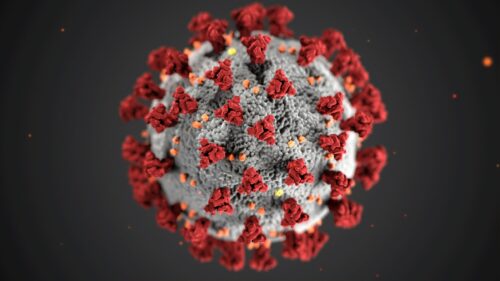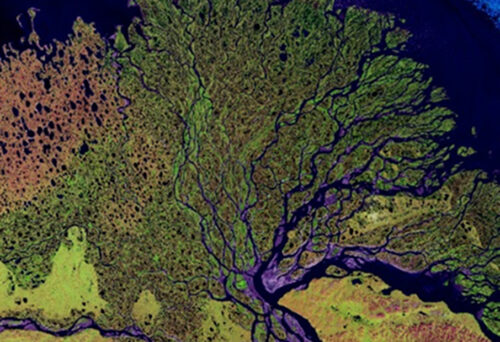Community Spotlight

Essay
When Mosquitoes Meet a Warming World: The Rising Risk of Disease
From a childhood fear of the Zika virus during the 2015–2016 outbreak to a deeper understanding of how climate change and human activity drive the spread of mosquito-borne diseases.
Photo caption: The Salton Sea in Southern California supports large populations of mosquitoes due to its warm climate and wetlands, which serve as ideal breeding grounds for mosquito-borne diseases. Photograph by Sherman Yang.
When Mosquitoes Became Personal
When I was in fourth grade, I lived in Southern California during the 2015-2016 Zika virus outbreak, where the warm climate led to long mosquito seasons and gave us every reason to be afraid. The news replayed videos of babies with large eyes and impossibly shrunken skulls—microcephaly, a possible consequence if a pregnant woman contracts Zika. They warned about the dangers of being bitten by the black-and-white striped mosquitoes, which had increased in population in recent years. These mosquitoes, Aedes aegypti (also known as yellow fever mosquitoes), were cesspools of disease. I was young, but I understood one thing: If I were to be bitten and get sick, it would be very bad indeed.

That summer, I became deathly terrified of mosquitoes, but that didn’t stop me from engaging in my summer activities. I still swam, biked, and stayed out past dusk for the Fourth of July. But when I inevitably came home with bites on my ankles, an inkling of terror would engulf me. What if it were a bad mosquito? What if I had Zika?
Zika and the Bigger Picture of Mosquito-Borne Diseases
A recent global pandemic, scary wildfires, and dozens of bug bites later, my fear of the Zika virus has diminished. It’s a relatively rare disease today. But, in retrospect, I was justified in being concerned about Zika. Cases in the U.S. reached an all-time high in 2016, with over 4,900 cases acquired from travel, and over 200 cases locally spread. That year, in California alone, there were 769 reported cases of the Zika virus.
Zika’s rise is not a unique case. Other mosquito-borne illnesses also saw upticks in the last decade. Although malaria, a mosquito-borne parasitic disease killing hundreds of thousands annually, has been on the decline since 2005, certain regions are still at risk.
How Human-Induced Climate Change Fuels Mosquito Expansion
In a 2021 Lancet Planetary Health article that used modeling to predict the incidence of mosquito-borne diseases, I learned that “The population at risk of malaria and dengue will be higher in densely populated urban areas in the WHO African region, South-East Asia region, and the region of the Americas.”
The authors noted that they did not account for “urban-heat island effects” in cities filled with concrete, which traps and conducts more heat, and further alters the risk of disease transmission. This is when I understood that the human population is both a victim and an instigator. Human-induced climate change contributes to the spread of infectious diseases, and here are just some examples.
- Increased Urbanization. A growing human population means that more space is required. The interaction between human settlement and wilderness, known as the wildland-urban interface, is known for a higher proportion of zoonotic disease. As urban regions become more densely populated, disease spreads more easily: the closer people live together, the more efficiently mosquitoes can transmit viruses and bacteria among susceptible populations.
- Extending Mosquito Habitats. Mosquitoes rely on high temperatures to breed, and extended warming seasons allow their populations to grow. Regions at higher latitudes and altitudes—normally too cold or too dry for mosquitoes—are becoming increasingly accessible due to prolonged tropical storm seasons and shifting weather patterns.
The World Mosquito Program also highlights the interconnectedness of climate change and mosquito-borne diseases, noting that changes in human behavior play a role. As droughts become more frequent, people without a steady water supply are more prone to store water throughout the summer, creating ideal breeding grounds for mosquitoes.
From Fear to Curiosity: Choosing Science
Today, as an undergrad at Yale University studying Ecology and Evolutionary Biology, I’ve chosen to replace fear with curiosity. I work in the Sorrells Lab at Yale School of Medicine, investigating how specific signaling proteins help mosquitoes detect host cues like CO2, heat, and body odor. My days consist of rearing mosquitoes from eggs, feeding their larvae, and tending to the Aedes aegypti species—the very species responsible for millions of deaths worldwide. The research doesn’t progress too quickly, but it moves along. I know that my participation in the work will produce data that could one day be used to disguise human scent from these unassumingly dangerous predators.
Each time I stick my bare arm into a net cage with hundreds of biting mosquitoes, I have hope that one day we will find a way to end mosquito-borne disease transmission once and for all.
More Information
References
- California Department of Public Health. (2025, August 1). CDPH monthly update on number of Zika infections in California. https://www.cdph.ca.gov/Programs/CID/DCDC/Pages/ZikaInfectionsUpdate.aspx
- Cao, Y., Wu, H., Zhang, Y., Wu, X., Li, J., Chen, H., & Gao, W. (2024). Time trends in malaria incidence from 1992 to 2021 in high-risk regions: An age–period–cohort analysis based on the Global Burden of Disease study 2021. International Journal of Infectious Diseases, 153, 107770. https://doi.org/10.1016/j.ijid.2024.107770
- Centers for Disease Control and Prevention. (2025, September 2). Zika cases in the United States. https://www.cdc.gov/zika/zika-cases-us/index.html
- Colón-González, F. J., Sewe, M. O., Tompkins, A. M., Sjödin, H., Casallas, A., Rocklöv, J., Caminade, C., & Lowe, R. (2021, July). Projecting the risk of mosquito-borne diseases in a warmer and more populated world: A multi-model, multi-scenario intercomparison modelling study. The Lancet Planetary Health, 5(7), e404–e414. https://doi.org/10.1016/S2542-5196(21)00132-7
- Jackson, A. (2022, April 22). Explainer: How climate change is amplifying mosquito-borne diseases. World Mosquito Program. https://www.worldmosquitoprogram.org/en/news-stories/stories/explainer-how-climate-change-amplifying-mosquito-borne-diseases
- Planetary Health Alliance. (2025, March). Infectious diseases. https://planetaryhealthalliance.org/themes/infectious-diseases/
- World Health Organization. (n.d.). Zika virus disease outbreak 2015–2016. https://www.who.int/emergencies/situations/zika-virus-outbreak
About the Author
 Michelle So is an undergraduate at Yale majoring in Ecology and Evolutionary Biology and Global Health Studies. She believes in the power of narrative storytelling in climate advocacy and medicine, and contributes to the Yale Daily News as a Sci-Tech writer and edits for the Scientific Magazine and the Global Health Review.
Michelle So is an undergraduate at Yale majoring in Ecology and Evolutionary Biology and Global Health Studies. She believes in the power of narrative storytelling in climate advocacy and medicine, and contributes to the Yale Daily News as a Sci-Tech writer and edits for the Scientific Magazine and the Global Health Review.
Michelle is a research assistant in the Post Lab of aquatic ecology and volunteers for the Living History Project, where she documents the stories of terminal patients. She became interested in Planetary Health after attending the Johns Hopkins Global Health Leaders Conference and learning about climate change’s impact on human lifespan.
Through her writing, she hopes to collaborate with the Planetary Health Alliance to advocate for healthcare equity and environmental justice.








